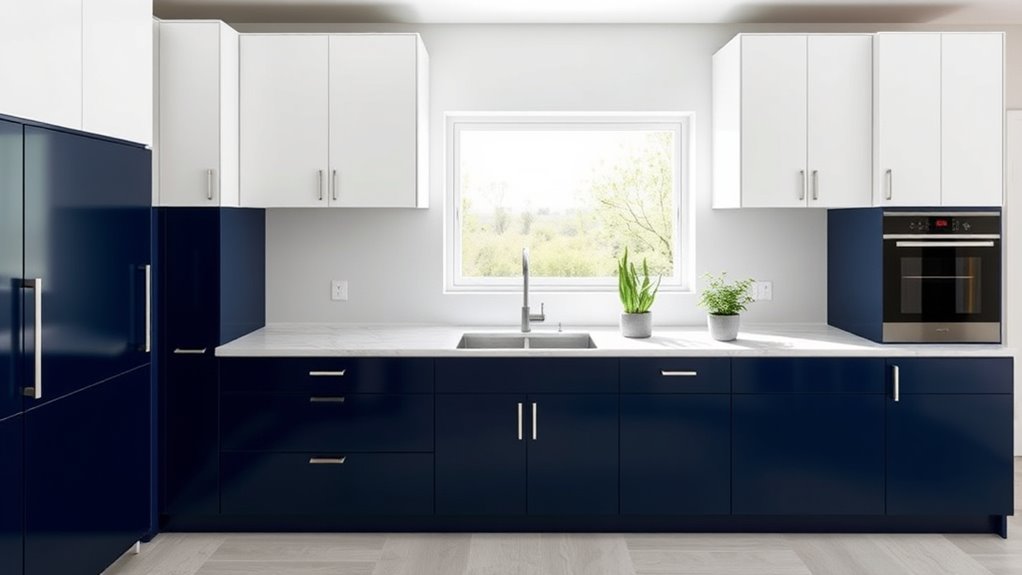If you’re looking to enhance your kitchen’s style, two-tone cabinets are a great choice. You can pair white upper cabinets with dark navy or charcoal lowers for a striking contrast, or combine pastel blues with warm wood tones for a softer look. Bold options like black and white create a timeless feel, while mixing shades like blush pink and beige add warmth. Experiment with materials and textures to find a combination that reflects your personality—keep exploring to discover more ideas.
Key Takeaways
- Combine white upper cabinets with dark navy or charcoal lowers for striking contrast.
- Use pastel shades paired with warm wood tones for a soft, inviting look.
- Create bold contrasts like black and white for a timeless, modern aesthetic.
- Mix materials such as painted wood with natural finishes for visual and tactile interest.
- Incorporate metal accents and glass-front cabinets to enhance the overall design and style.

A two-tone kitchen cabinet design can instantly elevate your space by adding visual interest and personality. It’s a stylish way to create a focal point and showcase your unique taste. The key to making this design work is choosing the right color combinations and material contrasts. When you mix two different colors, you can highlight particular areas or features of your kitchen, making it feel more dynamic and personalized. For example, pairing a crisp white upper cabinet with dark navy or charcoal lower cabinets creates a striking contrast that draws the eye and adds depth. You might also opt for softer hues, like pastel blues combined with warm wood tones, to produce a more subtle, inviting look.
Color combinations are the foundation of a successful two-tone kitchen. Think about the mood you want to set—bold and modern or cozy and traditional—and select shades accordingly. Bright, contrasting colors like black and white offer a timeless, chic aesthetic, while softer shades like blush pink and creamy beige can bring warmth and charm. You can also experiment with more unexpected pairings, such as emerald green and matte black or deep burgundy and light gray, to make your kitchen uniquely yours. The goal is to find a harmonious balance that complements your overall décor and personal style.
Material contrasts are just as important as color choices. Combining different materials adds texture and tactile interest, making your cabinets stand out even more. For instance, pairing sleek, painted wood with natural wood finishes creates a pleasing visual and tactile contrast. You could go for matte painted cabinets on the upper level with glossy or stained wood on the bottom to emphasize different zones. Incorporating metal accents, like brushed brass handles or black matte hardware, enhances the contrast further and adds a modern touch. Additionally, mixing materials like glass-front upper cabinets with solid wood lowers not only creates contrast but also allows you to display decorative items while keeping the space feeling open.
When you blend color combinations with material contrasts thoughtfully, you craft a kitchen that’s both functional and visually engaging. The contrast in textures and shades guides the eye around the room, highlighting architectural details and design features. Remember, the key to success lies in balancing these elements so nothing feels out of place. By carefully selecting your color palette and material pairings, you set the tone for an inviting, stylish kitchen that truly reflects your personality. This approach gives you the flexibility to experiment and create a space that’s as unique as you are. Additionally, understanding automation in business can inspire innovative ideas for integrating smart features into your kitchen design, enhancing both functionality and aesthetics.
Frequently Asked Questions
How Do I Choose Complementary Two-Tone Color Combinations?
To select complementary two-tone color combinations, you should focus on effective color pairing and contrast balance. Pick colors that enhance each other, such as a light shade paired with a darker one, to create visual interest without overwhelming the space. Consider the overall style of your kitchen, and test different contrasts to find a harmonious blend. This approach ensures your cabinets stand out beautifully while maintaining a cohesive look.
What Are the Best Materials for Two-Tone Cabinets?
Did you know that 85% of homeowners prefer durable materials for their kitchen cabinets? For your two-tone cabinets, opt for materials like solid wood or plywood, known for their material resilience. These materials handle wear and moisture well. Additionally, choose high-quality paint finishes, such as semi-gloss or matte, to enhance longevity and beauty. This combination ensures your cabinets stay vibrant and functional for years to come.
How Can I Incorporate Two-Tone Cabinets Into Small Kitchens?
You can incorporate two-tone cabinets into your small kitchen by choosing a light color for upper cabinets and a darker shade for lower ones, creating a sense of height and depth. Add a bold color accent to one cabinet to make it pop, and select sleek cabinet hardware to enhance the look. Keep the design simple and avoid clutter to maximize space, making your small kitchen feel open and stylish.
Are Two-Tone Cabinets More Expensive Than Single-Tone Options?
Two-tone cabinets can be more expensive than single-tone options, mainly due to the cost comparison of materials and finishes. You might pay extra for the additional paint or veneer, and installation costs could rise if the design is more complex. However, the overall price depends on your choices. By selecting affordable materials and simplifying the design, you can keep costs manageable while enjoying the stylish contrast two-tone cabinets offer.
How Do I Maintain and Clean Two-Tone Kitchen Cabinets?
You’ll want to treat your two-tone kitchen cabinets like precious treasures! Use gentle cleaning techniques—warm water, mild soap, and a soft cloth—to avoid damaging the paint or finish. For material maintenance, wipe spills immediately and avoid harsh chemicals. Regularly dust and polish to keep colors vibrant and surfaces sleek. With consistent care, your cabinets will stay stunning, as if they’re freshly crafted, for years to come!
Conclusion
So, next time you choose your kitchen cabinets, maybe don’t stick to just one color. After all, who knew that mixing shades could actually make your space more stylish? It’s almost like breaking the rules is the secret to a stunning kitchen! So go ahead, embrace those bold two-tone ideas—you might just surprise yourself and everyone else with how effortlessly chic your kitchen becomes. After all, playing it safe is so last season.









